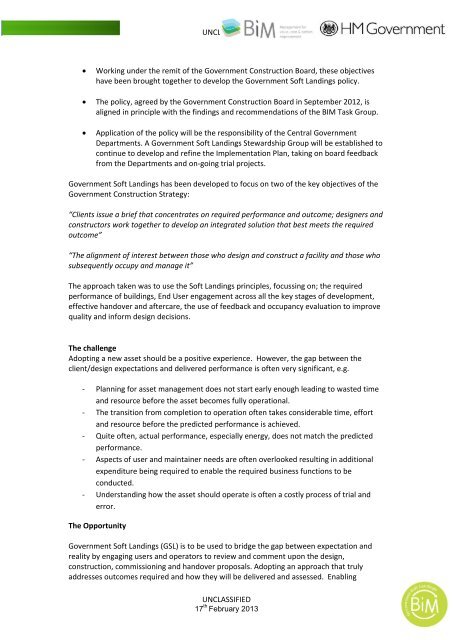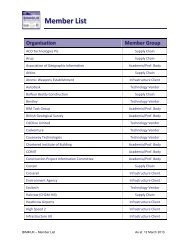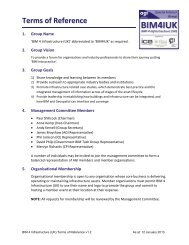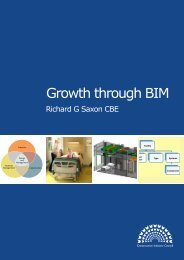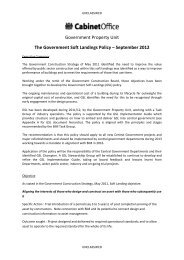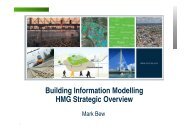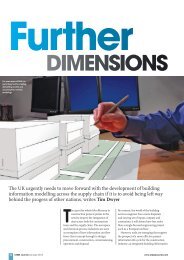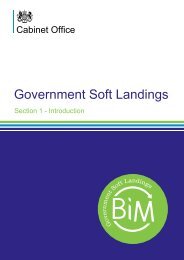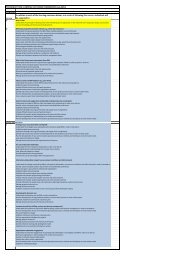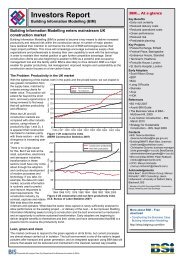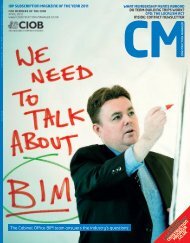Government Soft Landings â Departmental ... - BIM Task Group
Government Soft Landings â Departmental ... - BIM Task Group
Government Soft Landings â Departmental ... - BIM Task Group
- No tags were found...
Create successful ePaper yourself
Turn your PDF publications into a flip-book with our unique Google optimized e-Paper software.
UNCLASSIFIED• Working under the remit of the <strong>Government</strong> Construction Board, these objectiveshave been brought together to develop the <strong>Government</strong> <strong>Soft</strong> <strong>Landings</strong> policy.• The policy, agreed by the <strong>Government</strong> Construction Board in September 2012, isaligned in principle with the findings and recommendations of the <strong>BIM</strong> <strong>Task</strong> <strong>Group</strong>.• Application of the policy will be the responsibility of the Central <strong>Government</strong>Departments. A <strong>Government</strong> <strong>Soft</strong> <strong>Landings</strong> Stewardship <strong>Group</strong> will be established tocontinue to develop and refine the Implementation Plan, taking on board feedbackfrom the Departments and on-going trial projects.<strong>Government</strong> <strong>Soft</strong> <strong>Landings</strong> has been developed to focus on two of the key objectives of the<strong>Government</strong> Construction Strategy:“Clients issue a brief that concentrates on required performance and outcome; designers andconstructors work together to develop an integrated solution that best meets the requiredoutcome”“The alignment of interest between those who design and construct a facility and those whosubsequently occupy and manage it”The approach taken was to use the <strong>Soft</strong> <strong>Landings</strong> principles, focussing on; the requiredperformance of buildings, End User engagement across all the key stages of development,effective handover and aftercare, the use of feedback and occupancy evaluation to improvequality and inform design decisions.The challengeAdopting a new asset should be a positive experience. However, the gap between theclient/design expectations and delivered performance is often very significant, e.g.- Planning for asset management does not start early enough leading to wasted timeand resource before the asset becomes fully operational.- The transition from completion to operation often takes considerable time, effortand resource before the predicted performance is achieved.- Quite often, actual performance, especially energy, does not match the predictedperformance.- Aspects of user and maintainer needs are often overlooked resulting in additionalexpenditure being required to enable the required business functions to beconducted.- Understanding how the asset should operate is often a costly process of trial anderror.The Opportunity<strong>Government</strong> <strong>Soft</strong> <strong>Landings</strong> (GSL) is to be used to bridge the gap between expectation andreality by engaging users and operators to review and comment upon the design,construction, commissioning and handover proposals. Adopting an approach that trulyaddresses outcomes required and how they will be delivered and assessed. EnablingUNCLASSIFIED17 th February 2013


